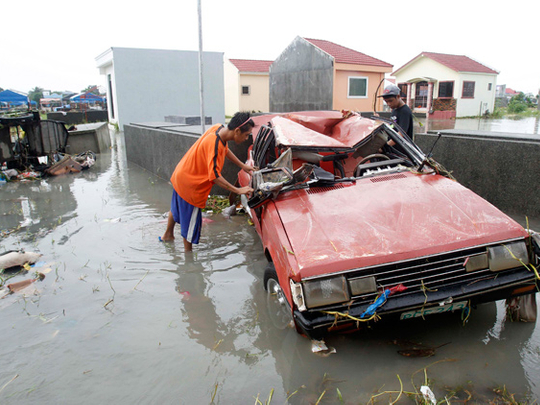
Manila: Nine were killed and one million were displaced as Tropical Storm Trami triggered southwest monsoon rains that flooded in three days two thirds of the Philippines, including Metro Manila which was 80 per cent submerged, officials told Gulf News.
Nelson Faustino Jr, 20, died by drowning when he and his companions tried to cross a river at the boundary of Teresa and Morong in Metro Manila’s eastern suburban Rizal on Tuesday, making him the ninth fatality after three days of relentless rains left one million people in 1,028 villages, 80 towns, 35 cities in northern and southern Luzon, including Metro Manila, said Undersecretary Eduardo del Rosario, head of the National Disaster Risk Reduction and Management Council (NDRRMC).
Majority of the fatalities occurred in northern Luzon, where four more were also reported missing as Tropical Storm Trami hovered from a distance, more than 500 kilometres northeast and later, northwest off Batanes from Sunday to Wednesday, respectively, said Del Rosario.
Trami sucked in monsoon rains and winds as it slowly moved northward, away from the Philippines’ area of responsibility, at 20 kilometres per hour, with winds of 105 kilometres per hour and gustiness of 135 kilometres per hour, said the weather station, adding that weather would improve in all affected areas when Trami finally leaves for the South China Sea on Thursday morning.
Relentless rains brought about initially by 10 to 25 millimetres of rains per hour and later by 40 millimetres of rain per hour flooded 347 areas in 42 municipalities and five affected regions in northern and southern Luzon and Metro Mania, said the weather station.
Floods ranged from waist high to more than two metres, on roads and community centres, said NDRRMC head del Rosario, adding that one third of the one million were placed at evacuation centres that were established in public schools, Catholic churches, and government offices.
“After two days of rains since Sunday, the streets near Quezon City’s East Riverside turned into lakes. Our houses near the riverbank were like boats on a raging river,” recalled Wilmer Toleng, adding that his father “Boy,” a stroke victim, was hoisted out of the house through the roof and brought to a safe area, across a small street that was a virtual lake, with the help of a rope strung on houses.
“We didn’t have time to look around when we left our home,” said Toleng, adding, “We ran away fast. I didn’t cry. I tried to be strong because I wanted to save my parents, brothers, sisters. nieces and nephews from the flood.”
The ten metre deep river bank where his house perched overflowed and flooded the streets more than three metre high.
On Tuesday, 60 per cent of Metro Manila was flooded, but 80 per cent was eventually submerged on Wednesday, said del Rosario.
Poor residents of Tumana, in Marikina, a flood prone area, were rescued from the rising floods until late afternoon of Tuesday. They were brought to an evacuation center and were not allowed to return to their homes on Wednesday, said a social worker.
Marikina River rose again on Wednesday because a counterpart dam opened several gates to release water.
Public and private relief operations were mobilised nationwide in all affected areas.
The Sto. Domingo Catholic Church in Quezon City opened its wide sanctuary to the homeless and called for relief assistance from social workers, but priest warned that politicians should bring in goods without cameramen.
President Benigno Aquino visited a school in Binan, Laguna, southern Luzon on Wednesday. It was a hard hit area. “You’re government is here,” said Aquino in a covered court in San Pedro, Laguna,
Manila Archbishop Antonio Tagle called for prayers and the revival of the “Bayanihan” spirit, or assistance for calamity victims.
Local government leaders also declared majority of affected areas in a state of calamity.
About 20 typhoons visit the Philippines every year, starting June.














